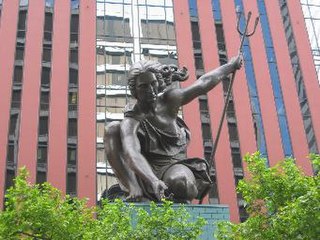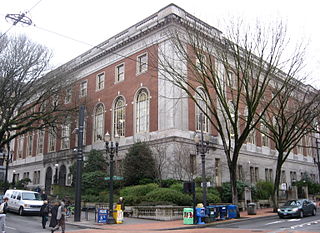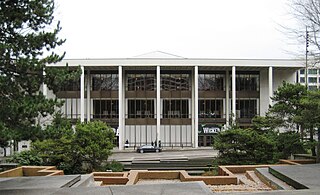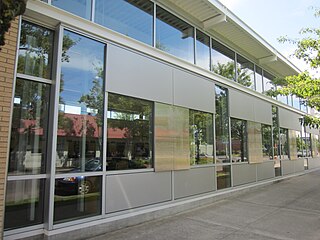
Michael Graves was an American architect, designer, and educator, and principal of Michael Graves and Associates and Michael Graves Design Group. He was a member of The New York Five and the Memphis Group and a professor of architecture at Princeton University for nearly forty years. Following his own partial paralysis in 2003, Graves became an internationally recognized advocate of health care design.

Portlandia is a sculpture by Raymond Kaskey located above the entrance of the Portland Building in downtown Portland, Oregon. It is the second largest copper repoussé statue in the United States, after the Statue of Liberty.

Providence Park is an outdoor soccer venue located in the Goose Hollow neighborhood of Portland, Oregon. It has existed in rudimentary form since 1893, and as a complete stadium since 1926. Providence Park is currently the oldest facility to be configured as a soccer-specific stadium for use by a MLS team, and is one of the most historic grounds used by any United States professional soccer team.

Postmodern architecture is a style or movement which emerged in the late 1950s as a reaction against the austerity, formality, and lack of variety of modern architecture, particularly in the international style advocated by Philip Johnson and Henry-Russell Hitchcock. The movement was introduced by the architect and urban planner Denise Scott Brown and architectural theorist Robert Venturi in their 1972 book Learning from Las Vegas. The style flourished from the 1980s through the 1990s, particularly in the work of Scott Brown & Venturi, Philip Johnson, Charles Moore and Michael Graves. In the late 1990s, it divided into a multitude of new tendencies, including high-tech architecture, neo-futurism, new classical architecture, and deconstructivism. However, some buildings built after this period are still considered postmodern.

The Vista Bridge is an arch bridge for vehicles and pedestrians located in Portland, Oregon, United States. It connects the areas of King's Hill and Vista Ridge which are both in the Goose Hollow neighborhood. The MAX Light Rail line and Jefferson Street/Canyon Road travel under the bridge, and Vista Avenue crosses the bridge.

The Ladd Carriage House is a building in downtown Portland, Oregon, at Broadway and Columbia. It is one of the few surviving buildings forming part of the former grand estates which once stood in the downtown core. It is listed on the National Register of Historic Places.

The Bank of California Building, also known as the Durham & Bates Building and currently the Three Kings Building, is a historic former bank building in downtown Portland, Oregon, United States. It has been on the National Register of Historic Places since 1978. The three-story building was designed by A. E. Doyle in an Italianate style and completed in 1925. The ground floor features a two-story-high grand room with 36-foot (11 m) ceilings. The building's original owner and occupant, the Bank of California, moved out around the end of 1969 and sold the building in 1970. It has had a succession of other owners and tenants since then. It was last used as a bank in 1977.

The Public Service Building is a historic 67.06 m (220.0 ft), 15-story office building in downtown Portland, Oregon, United States. The building and its attached parking garage have been listed on the National Register of Historic Places as the Public Service Building and Garage since 1996. It was built to house the offices of the Portland Gas and Coke Company and the Pacific Power and Light Company. The building's name reflects the fact that these utilities were "public services". A space in the Public Service Building fronting the corner of Salmon and Sixth streets became the first Niketown store.

Portland City Hall is the headquarters of city government of Portland, Oregon, United States. The four-story Italian Renaissance-style building houses the offices of the City Council, which consists of the mayor and four commissioners, and several other offices. City Hall is also home to the City Council chambers, located in the rotunda on the east side of the structure. Completed in 1895, the building was added to the National Register of Historic Places on November 21, 1974. City Hall has gone through several renovations, with the most recent overhaul gutting the interior to upgrade it to modern seismic and safety standards. The original was built for $600,000, while the 1996 to 1998 renovation cost $29 million.

The Central Library is a three-story public library branch in the downtown core of Portland, Oregon, United States. Opened in 1913, it serves as the main branch of the Multnomah County Library system. In 1979, the Georgian style building was added to the National Register of Historic Places as the Central Building, Public Library. The library underwent major structural and interior renovations in the mid 1990s.
DLR Group is an employee-owned integrated design firm providing architecture, engineering, planning, and interior design. Their brand promise is to elevate the human experience through design. A self-described advocate for sustainable design, the firm was an early adopter of the Architecture 2030 Challenge, and an initial signatory to the AIA 2030 Commitment and the China Accord.

Keller Auditorium, formerly known as the Portland Municipal Auditorium, the Portland Public Auditorium, and the Portland Civic Auditorium, is a performing arts center located on Clay Street in downtown Portland, Oregon, United States. It is part of the Portland's Centers for the Arts. Opened in 1917, the venue first changed names in 1966, being renamed again in 2000 in honor of a $1.5 million renovation donation by Richard B. Keller. An extensive remodeling and modernization in 1967–68 effectively changed its original exterior appearance beyond recognition.

Venetian Hillsboro, last known as the Venetian Theatre & Bistro, is a former movie theater and performing arts venue in downtown Hillsboro, Oregon, United States, which since 2022 has been in use by a venue named Venetian Hillsboro. Formerly the Town Theater, the building re-opened in 2008 after more than a decade of inactivity and revitalization plans. Built in 1888 as a bank, later mayor Orange Phelps converted the property into a theater in 1911 and in 1925 converted it into a two-story Italianate building with a larger auditorium. Prior to renovation the theater was owned by the city of Hillsboro who purchased it from Act III Theatres.

Waldschmidt Hall is an academic building at the University of Portland in Portland, Oregon, United States. Constructed in 1891 as West Hall, the building was originally part of the now defunct Portland University located in North Portland overlooking the Willamette River. The Romanesque style structure built of brick and stone stands five stories tall. The hall was added to the National Register of Historic Places in 1977 and renovated in 1992, the same year it took the current name. Waldschmidt, the oldest building on campus, now houses the school's administration offices and some classrooms.

The Edith Green – Wendell Wyatt Federal Building is a high rise structure in downtown Portland, Oregon, United States. Opened in 1975, the 18 story-tower is owned by the Federal Government. The international style office building has more than 370,000 square feet (34,000 m2) of space. Designed by the Skidmore, Owings and Merrill architecture firm, the building is named after Wendell Wyatt and Edith Green who both served in the United States House of Representatives.

The Cornelius Hotel is a historic hotel building in downtown Portland, Oregon, United States that is listed on the National Register of Historic Places. It was designed by John V. Bennes's firm, and constructed in 1907–08. It ceased to be used as a hotel by the 1950s. A fire in 1985 left the top three floors of the structure uninhabitable. By the early 1990s, the building had been vacated, and it remained vacant for more than two decades. In 2016–2018, it was joined to the adjacent Woodlark Building, extensively renovated, and converted into a hotel. The Woodlark Hotel opened on December 15, 2018.

The Woodstock Library is a branch of the Multnomah County Library in southeast Portland, Oregon, United States. The library's origins date back to 1908, when the people of the Woodstock neighborhood established a reading room at the Woodstock Fire Station, which soon became one of fifteen "deposit stations". The Woodstock collection began as an assemblage of children's books and was housed within a public school. In 1911, the station was replaced by a "sub-branch" library offering more books for adults and children, but without the reference works and services available at regular branches. The collection moved into a larger facility in 1914, which became a full branch in 1917, offering additional resources and services.

The Northwest Library is a branch of the Multnomah County Library, in Portland in the U.S. state of Oregon. The branch, which opened in 2001, offers the Multnomah County Library catalog of two million books, periodicals and other materials.

The Ancient Order of United Workmen Temple, also known as the Tourny Building, was a historic building located at the intersection of Southwest 2nd Avenue and Taylor Street in Portland, Oregon, in the United States. The six-story building was completed in 1892 and it was demolished in 2017 to be replaced by new development. Demolition was underway in August 2017, and it was complete by November of the same year.
SERA Architects is an American architectural firm headquartered in Portland, Oregon, with a second office in Oakland, California. It is the fifth largest architecture firm in Portland, offering architectural, interior design, and urban design and planning services. Founded in Portland in 1968 by Architect Bing Sheldon, who led the Portland Downtown Plan to revitalize the city’s urban core, the firm’s early work focused on historic renovations and adaptive reuse projects. In 2015, SERA opened a second office in Mountain View, California.





















